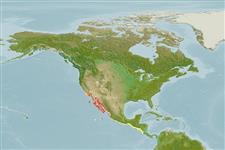Common names from other countries
Environment: milieu / climate zone / depth range / distribution range
Ecologia
marinhas associadas(os) a recifes; intervalo de profundidade 1 - 61 m (Ref. 2850). Subtropical; 37°N - 10°N, 123°W - 85°W
Eastern Central Pacific: Monterey in California, USA to Mexico, including the Gulf of California. Also reported in Nicaragua (Ref. 13613).
Length at first maturity / Tamanho / Peso / Idade
Maturity: Lm ?, range 9 - ? cm
Max length : 60.0 cm TL macho/indeterminado; (Ref. 26550); peso máx. Publicado: 900.00 g (Ref. 40637); Idade máx. registada: 20 anos (Ref. 56049)
Usually found on sand or mud bottom near rocks and eelgrass, from the coast to a depth of 60 m. A secretive species, it feeds on small fishes and benthic crustaceans during the day (Ref. 9342). Capable of tolerating ample fluctuations of temperature (from 7.5 to 32°C) and survive extreme cold intervals (Ref. 9342). Pelagic spawners (Ref. 56049). Important game fish caught in bays and harbors (Ref. 9342). Minimum depth range based on occurrence (Ref. 79604).
Pelagic spawner (Ref. 56049). Protogyny (Ref. 32126) as proposed has been corrected by a more detailed study on several species which confirmed this species and all of the members of the genus to be gonochoristic (Ref. 103751).
Eschmeyer, W.N., E.S. Herald and H. Hammann, 1983. A field guide to Pacific coast fishes of North America. Boston (MA, USA): Houghton Mifflin Company. xii+336 p. (Ref. 2850)
Categoria na Lista Vermelha da IUCN (Ref. 130435)
CITES (Ref. 128078)
Not Evaluated
Ameaça para o homem
Harmless
Utilização humana
Pescarias: sem interesse; peixe desportivo: sim
Mais informação
ReferênciasAquaculturaPerfil para aquaculturaEstirpesGenéticaElectrophoresesHereditariedadeDoençasProcessamentoMass conversion
ColaboradoresFotografiasStamps, Coins Misc.SonsCiguateraVelocidadeTipo de nataçãoÁrea branquialOutras referênciasCérebrosVisão
Ferramentas
Relatórios especiais
Descarregue XML
Fontes da internet
Estimates based on models
Preferred temperature (Ref.
115969): 18.1 - 26.8, mean 22.3 (based on 42 cells).
Phylogenetic diversity index (Ref.
82804): PD
50 = 0.5020 [Uniqueness, from 0.5 = low to 2.0 = high].
Bayesian length-weight: a=0.01288 (0.00809 - 0.02051), b=3.00 (2.88 - 3.12), in cm Total Length, based on LWR estimates for this species & Genus-body shape (Ref.
93245).
Nível Trófico (Ref.
69278): 4.1 ±0.56 se; based on food items.
Resiliência (Ref.
120179): Médio, tempo mínimo de duplicação da população 1,4 - 4,4 anos (tm=1.5; tmax=20; K=0.296).
Fishing Vulnerability (Ref.
59153): Moderate vulnerability (37 of 100).
